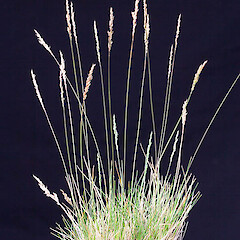Agrostis imbecilla
Common name
feeble bent
Synonyms
Agrostis tenella Petrie non Hoffm.
Family
Poaceae
Flora category
Vascular – Native
Endemic taxon
Yes
Endemic genus
No
Endemic family
No
Structural class
Grasses
NVS code
The National Vegetation Survey (NVS) Databank is a physical archive and electronic databank containing records of over 94,000 vegetation survey plots - including data from over 19,000 permanent plots. NVS maintains a standard set of species code abbreviations that correspond to standard scientific plant names from the Ngä Tipu o Aotearoa - New Zealand Plants database.
AGRIMB
Chromosome number
2n = 42
Current conservation status
The conservation status of all known New Zealand vascular plant taxa at the rank of species and below were reassessed in 2017 using the New Zealand Threat Classification System (NZTCS) – more information about this can be found on the NZTCS website. This report includes a statistical summary and brief notes on changes since 2012 and replaces all previous NZTCS lists for vascular plants.
Please note, threat classifications are often suggested by authors when publications fall between NZTCS assessment periods – an interim threat classification status has not been assessed by the NZTCS panel.
- Conservation status of New Zealand indigenous vascular plants, 2017 . 2018. Peter J. de Lange, Jeremy R. Rolfe, John W. Barkla, Shannel P. Courtney, Paul D. Champion, Leon R. Perrie, Sarah M. Beadel, Kerry A. Ford, Ilse Breitwieser, Ines Schönberger, Rowan Hindmarsh-Walls, Peter B. Heenan and Kate Ladley. Department of Conservation. Source: NZTCS and licensed by DOC for reuse under the Creative Commons Attribution 4.0 International licence.
2017 | Data Deficient | Qualifiers: Sp
Previous conservation statuses
2012 | Data Deficient | Qualifiers: Sp
2009 | At Risk – Naturally Uncommon
2004 | Sparse
Distribution
Endemic. North Island, one record from Moawhango. South Island, infrequent in Canterbury and Otago
Habitat
A montane, subalpine to alpine species of damp sites within tussock grassland.
Detailed description
Delicate, slender, tufted perennial plants (100–)150–350 mm tall, with long, rather fine, spike-like panicles on slender culms > overtopping leaves. Leaf-sheath narrow, membranous, light cream-brown to reddish, glabrous, distinctly ribbed. Ligule 0.8–1.6 mm, obtuse, lower surface glabrous. Leaf-blade 20–130 × 0.2–0.4 mm, involute, filiform, flaccid, undersides finely striate and, in young leaves scabrid, upper surface scabrid on ribs; margins scabrid, apex tapered, blunt. Culm filiform, erect or geniculate at base, internodes glabrous. Panicle (25–)50–90 × 2–3 mm, contracted, narrow-linear, pale purple. Spikelets 1.5–2.4 mm, pale greenish purple or pale yellow. Glumes equal, lanceolate, scabrid on keel and on margins near acute tip. Lemma 1.5–1.9 mm, glabrous, 5-nerved, ovate-oblong, apex denticulate, usually without awns, if present these up to 1 mm, scarcely projecting beyond glumes. Palea 0.1–0.2 mm, ovate. Callus with few minute hairs. Anthers 0.6–1 mm.
Manaaki Whenua Online Interactive Key
Similar taxa
A distinctive species characterised by its very fine, rather slender panicles, and rather lax to flaccid leaves.
Flowering
Unknown
Fruiting
Unknown
Life cycle
Florets are dispersed by wind and water (Thorsen et al., 2009).
Propagation technique
Easy from fresh seed and rooted pieces but will not flower without cold treatment. In humid climates it is difficult to maintain
Threats
Not directly threatened, but listed because it is a naturally uncommon species of sporadic occurrence.
Etymology
agrostis: Greek name for a kind of grass
imbecilla: Weak
Attribution
Fact sheet prepared for NZPCN by P.J. de Lange June 2005. Description modified from Edgar and Connor (2000)
References and further reading
Edgar E, Connor HE. 2000. Flora of New Zealand. Vol. V. Grasses. Christchurch, Manaaki Whenua Press. 650 p.
Thorsen MJ, Dickinson KJM, Seddon PJ. 2009. Seed dispersal systems in the New Zealand flora. Perspectives in Plant Ecology, Evolution and Systematics 11: 285–309.


